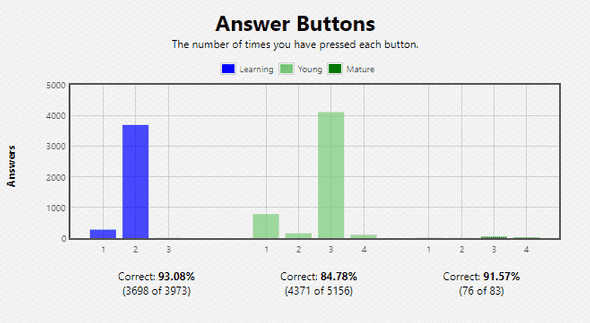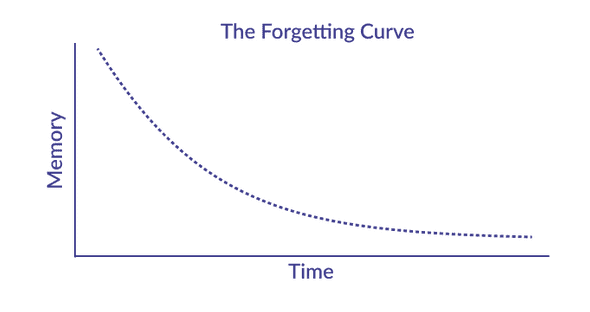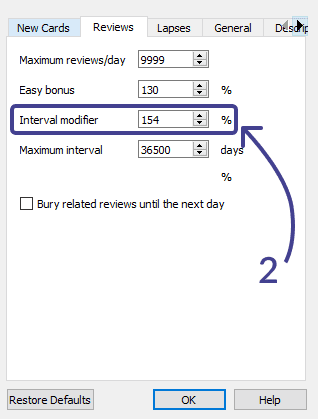What is Anki's Interval Modifier?
January 23, 2020
If you are trying to optimize your Anki settings, you should definitely be looking at your Interval Modifier.
Anki’s Interval Modifier takes the normal interval for a card and multiplies it by the interval modifier. You can use this to increase or decrease the default review time for every card.
Here is an example.
Let’s say you have a card where a Good answer will result in you seeing the card in 10 days (interval = 10). For now, let’s assume you have an Interval Modifier of 120%. Were you to implement that modifier, you would see the card next in 12 days instead of 10.
Interval * Interval Modifier = New Interval
10 days * 120% = 12 days (new interval)
Why Should I Change My Interval Modifier?
The Interval Modifier is a useful tool to adjust your retention percentage, the percentage of review cards that you answer correctly.
If your intervals are too small, you are seeing cards too often. If you’re seeing the same cards too often, you are lowering desirable difficulty (thus, lowering engagement and memory formation). Plus, you are wasting valuable time that could be used to learn new cards. This is known as something called “Ease Hell” in the Anki community. I wrote about how I escaped it while learning Chinese here.
If your intervals are too long, you are seeing cards too rarely. When you don’t see review cards frequently enough, you will forget the information before you have a chance to re-engage with it and maintain its memory. Your retention percentage will plummet, and review sessions will eventually become very frustrating.
Your Interval Modifier essentially trades time/frequency of reviews for retention rate. The less often you study, the lower your retention rate will be.
What Should I Set My Interval Modifier To?
Anki’s docs recommend aiming for a retention rate of 90%.
Your retention rate is going to depend on how well you need to know every piece of information,how long you have to study every day, and how difficult your cards are.
For language learning, I recommend a target retention rate of 85%. This is based on my personal experience learning Russian as well as attempting to learn 3,000 Chinese Characters in under 4 months.
With an 85% retention rate, you can get through a lot of reviews and still continue to learn a fair amount of new words every day.
When I was learning Chinese characters, I added 30 new cards to my deck every day and was able to finish my reviews in 30-45 minutes, leaving an hour to focus on new cards. Of course, it helped that I tried very hard to come up with good mnemonics up front that would save me time re-learning the card later down the line.
That said, if you need to know information better and are satisfied with a 90% rate, that is personal preference.
Anything above 90%, and you are likely repeating cards too frequently.
Here is how to find your retention rate:
- Go to a deck
- Select “Stats”
- Scroll down to “Answer Buttons”
- Your retention rate will be the % of times you answered with a Correct button.
 Ignore the blue “Learning” category for now. Depending on the age of the deck you are optimizing for, you’ll want to consider both “Young” and “Mature” cards.
Ignore the blue “Learning” category for now. Depending on the age of the deck you are optimizing for, you’ll want to consider both “Young” and “Mature” cards.
Anki’s docs recommend not changing the Interval Modifier until you have plenty of Mature cards, but I have found that it’s fine to tweak my settings a little sooner than that. No need to spend months over-reviewing only to increase your Interval Modifier down the line.
Use Retention Rate to Find the Optimal Interval Modifier
The formula to adjust your Interval Modifier is:
Interval Modifier = log(desired retention%) / log(current retention%)
If you want to target 85% retention and you’re currently at 90% retention, you would make the following calculation:
Interval Modifier = log(0.85) / log(0.90) = 154%
How to Decide on Your Desired Retention Rate
Just as the forgetting curve (how forget over time) is non-linear, the relationship between time spent studying and retention rate is also non-linear.

Imagine a scenario where you study 90 minutes a day and are able to achieve a retention rate of 85%. If you decide you would rather have that rate be more like 90%, you are going to set the Interval Modifier to 65% so your cards more often:
log(0.90)/log(0.85) = 65%
This means you’re going to spend 35% (!) more time, or an extra 30 minutes, studying your cards every day. So while 5% better doesn’t sound like a big ask, you’re going to end up spending a lot more time than you realize to get that next 5% of retention.
To get to 95% from 85%, you’re going to have to spend 68% more time, or an extra hour, studying your cards every day.
How to Change the Interval Modifier in Anki
Once you’ve determined what you want to set your Interval Modifier to in Anki, click on the gear icon next to your deck.
Next, choose the “Review” tab at the top, and you’ll find Interval Modifier on the list. Don’t worry about the other ones for now.
You’re all set! Thanks for reading!
I send language learning tips and updates every Saturday.

